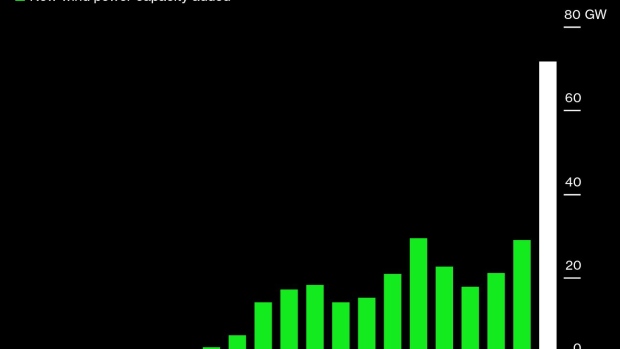
Wind turbines and solar panels in this aerial photograph taken near Fuxin, Liaoning province, China, on Monday, Nov. 16, 2020. When the Communist Party took over in 1949, leader Mao Zedong made Fuxin, where coal has been extracted since the 1700s, central to his efforts to modernize the nation. By 2005, easy-to-reach fuel was tapped out and the mine declared bankruptcy and Fuxin is still struggling to adapt. , Bloomberg
China blew past its previous record for renewable energy installations last year with a massive — and surprising — addition of wind power.
The National Energy Administration said in a press release on Wednesday that China added almost 72 gigawatts of wind power in 2020, more than double the previous record. The country also added about 48 gigawatts of solar, the most since 2017, and about 13 gigawatts of hydropower.
China’s previous record for new renewables capacity across all technologies was about 83 gigawatts in 2017, according to BloombergNEF.
The wind and solar installations were unexpectedly high, especially as they imply massive additions in the last weeks of 2020. The China Electricity Council had previously reported that as of the end of November, China had installed 24.6 gigawatts of wind and 25.9 gigawatts of solar for the year.
“It was quite a surprise to see wind power installations of 48 gigawatts in December,” said Robin Xiao, an analyst with CMB International Securities Corp. “Solar installations also beat expectations, but on more realistic grounds.”
The wind and solar figures were so high that analysts questioned whether the government adjusted the way it calculated capacity. The cutoff date for some onshore wind and solar subsidies was Dec. 31, and given that projects were delayed for months because of the pandemic, it may have allowed partially completed installations to count their entire capacity, Xiao said.
Against “the backdrop of carbon-neutral development, I think the Chinese government will tend to adopt relatively relaxed standards to promote the sector’s development,” he said.
View: Source
View: More news



